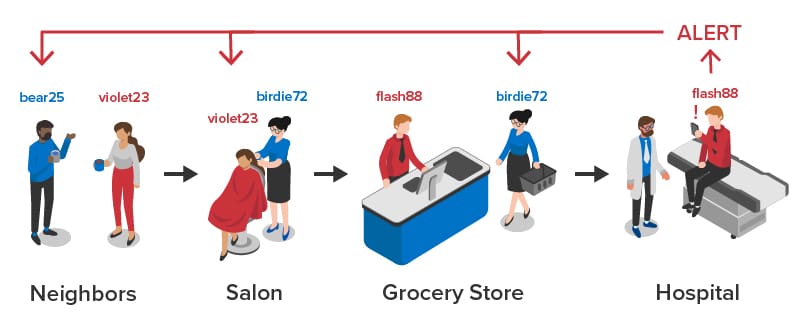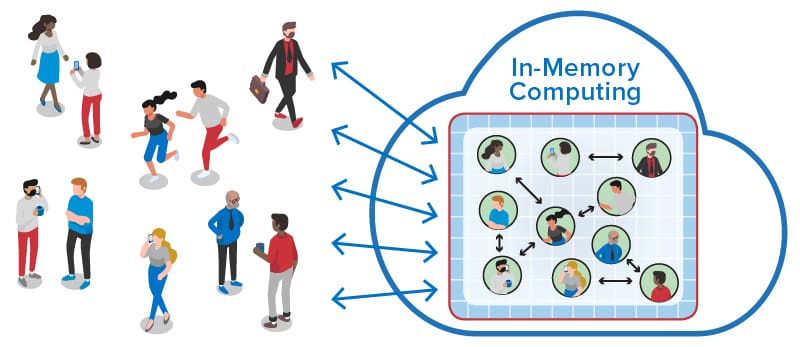Cloud Software Lets Millions Track Risky Contacts
A New Approach: Log Our Own Contacts in Advance
As we all know, getting people back to work will require testing and contact tracing. The latter will need armies of people to track down all contacts of each person who tests positive for coronavirus. Leading software companies are building mobile apps to log the places we have been and determine possible contacts. However, these apps will be complex by relying on Bluetooth wireless technology to detect proximity, and they raise concerns regarding both accuracy and privacy. Experts have stated that humans need to be in the loop for contact tracing to be effective. Maybe there’s a hybrid approach that offers promise in the near term.
What if we could easily and anonymously let people keep track of encounters as they occur that they judge to be potentially risky, such as with work colleagues, merchants, neighbors, and friends? As people log these contacts using aliases for privacy, cloud software could build a web of connections, often connecting strangers through intermediaries. Later, when a person tests positive, he or she could notify this software. It then could follow the breadcrumbs and anonymously alert via text message or email all people who recently came into contact and should be tested and/or self-isolated.
Here’s an example. When a grocery checker with the alias “flash88” tests positive for COVID-19, he can anonymously alert a chain of people who are connected by direct or intermediate contacts who have logged significant, recent encounters, such as haircuts or backyard barbeques:

Although voluntarily “self-tracing” our contacts would require proactive effort for each of us to log individual encounters, it could be done quickly and simply by just entering a person’s anonymous alias into a mobile app or web page. Most people likely would choose to do this only for lengthy interactions, such as with colleagues working closely together, friends at a barbeque, or perhaps a hairdresser or server at a restaurant. Location information could be included if permitted. What emerges from countless individual actions is a massive, continuously evolving web of contacts that can be immediately called upon for alerting when anyone tests positive.
For self-tracing to be effective, people who come into mutual contact need to register aliases and contact information (email or mobile number) with the software. As each person encounters a potentially risky contact and logs that contact’s alias, the system builds a record of the contact just for the period of time that risk of infection is possible, possibly two weeks. Regular work contacts could automatically be refreshed on a schedule.
The power of self-tracing is its ability to give us automatic, immediate — and anonymous — notification of exposure risk from a chain of contacts. While this tool does not replace standard contact tracing, it can add important value in its simplicity, timeliness, and incorporation of human judgment. As an alternative to more complicated and invasive Bluetooth-based contact tracing software, it could help accelerate the return to work for colleagues and businesses while offloading some of the work for contact tracers.
Advanced Capabilities
Beyond just tracking contacts, cloud-hosted software can keep track of important statistics, such as when and where (if permitted) a person tested positive or was alerted and how many in a chain separate a person from the source of an alert. Real-time analytics can continuously evaluate this data to immediately identify important trends, such as the locations where an unusually large number of alerts are occurring. This allows personnel to quickly respond and institute a self-isolation protocol where necessary.
Real-time analytics also can generate other useful statistics, such as the average chain length that results in co-infection and the percentage of connected people who actually become co-infected. If anonymous demographics are maintained and submitted by users, statistics can be computed by gender, age, and other parameters useful to healthcare professionals.
The Tech: In-Memory Cloud Computing Makes Self-Tracing Fast and Scalable
Cloud-hosted software technology called in-memory computing makes this contact tracing technique fast, scalable and quickly deployable. (It also can be used to assist other contact tracing efforts and for asset tracking.) While simultaneously tracking contacts for millions of people, this software can alert all related contacts in a matter of seconds after notification, and it can send out many thousands of alerts every second.
When a person tests positive and notifies the software, a cloud-based system uses the record of contacts kept with each person to send out alerts, and it follows these records from contact to contact until all mutually connected people have been alerted. In addition, human contact tracers could take advantage of this network (if permitted by users) to aid in their investigations.
ScaleOut Software has developed an in-memory, cloud-hosted software technology called real-time digital twins which make hosting this application easy, fast, and flexible. As illustrated below, cloud software can maintain a real-time digital twin for each user being tracked in the system to keep dynamic data for both alerting and real-time analytics. In addition to processing alerts, this software continuously extracts dynamic data from the real-time digital twins and analyzes it every few seconds. This makes it possible to generate and visualize the statistics described above in real time. Using real-time digital twins enables an application like this to be implemented within just a few days instead of weeks or months.

Note: To the extent possible, ScaleOut Software will make its cloud-based ScaleOut Digital Twin Streaming Service™ available free of charge (except for fees from the cloud provider) for public institutions needing help tracking data to assist in the COVID19 crisis.
Summing Up
Anonymous, voluntary, contact self-tracing has the potential to fill an important gap as a hybrid approach between manual contact tracing and complex, fully automated, location-based technologies. In work settings, it could be especially useful in protecting colleagues and customers. It offers a powerful tool to help contain the spread of COVID19, maximize situational awareness for healthcare workers and contact tracers, and minimize risks from exposure for all of us.
